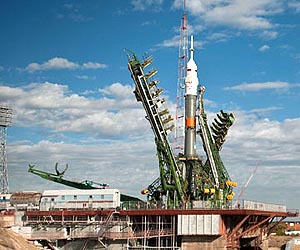 Launch scaffolding is raised into place around the Soyuz rocket shortly after arrival to the launch pad Tuesday at the Baikonur Cosmodrome in Kazakhstan. Credit: NASA/Carla Cioffi Russia holds 1st place on space launch market MOSCOW, Oct. 5 (Xinhua) Russia held the first place in terms of space launches, according to the report of the Russian space agency, Roskosmos, published by RIA Novosti news agency on Tuesday. Since the start of 2010, Russia made 22 launches. Of this number, 16 were made from Kazakhstan-located Baikonur site, five from Russian Plesetsk and one from a launching site of Dombarovskaya missile division, Roskosmos' report said. These launches have been made for service of the Defense Ministry, GLONASS navigation system and federal space programs. For the same period, the United States made 11 launches, and China sent to space 10 rockets. This is the third year in a row that Russia occupies the first place on the space launches market. In 2009, the frequency of Russian flights to the International Space Station rose twofold compared with that in 2008. |
Baikonur, Kazakhstan (SPX) Oct 06, 2010
The Soyuz spacecraft that will carry three new Expedition 25 flight engineers to the International Space Station was rolled out to the launch pad at the Baikonur Cosmodrome in Kazakhstan on Tuesday.
NASA astronaut Scott Kelly and Russian cosmonauts Alexander Kaleri and Oleg Skripochka will launch aboard the new Soyuz TMA-01M Thursday at 7:10 p.m. EDT (Friday, Kazakhstan time) and begin a five-month tour of duty aboard the station after docking to the Poisk module Saturday evening.
Meanwhile, the three Expedition 25 crew members already living and working aboard the station conducted a depressurization drill, collected data for science research and prepared for the installation of a device to produce water.
Commander Doug Wheelock began his workday early by participating in the Pro K experiment, which studies dietary countermeasures to lessen the bone loss experienced by astronauts during long-duration spaceflight.
With assistance from Flight Engineer Shannon Walker, Wheelock collected a blood sample and stored it in the Minus Eighty-Degree Laboratory Freezer for ISS for study later by scientists back on Earth.
Walker spent much of her morning with the Capillary Flow Experiment for an investigation of capillary flows and flows of fluids in containers with complex geometries.
Results of this study will improve current computer models used by designers of low-gravity fluid systems and may improve fluid transfer systems on future spacecraft.
Flight Engineer Fyodor Yurchikhin continued unpacking cargo from the ISS Progress 39 spacecraft that has been docked to the aft port of the Zvezda service module since September
Later Yurchikhin joined Wheelock and Walker for an emergency drill to sharpen the crew's response to a rapid, unexpected loss of cabin pressure within the station. Afterward the three tagged up with flight controllers for a debrief of the drill.
After a break for lunch, Wheelock used a ham radio to speak with students at the Institute of Research and Education in Italy and answered a variety of questions about life aboard the space station.
Wheelock then tagged up with flight controllers to discuss the upcoming installation of the Sabatier, which combines carbon dioxide from the Carbon Dioxide Removal Assembly and hydrogen from the Oxygen Generation System to form water and methane.
The water will be recycled by the Water Processor Assembly, and the methane vented overboard.
www.space-travel.com
No comments:
Post a Comment